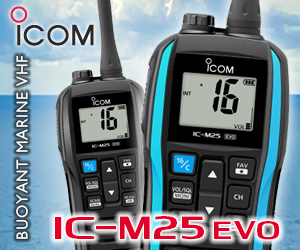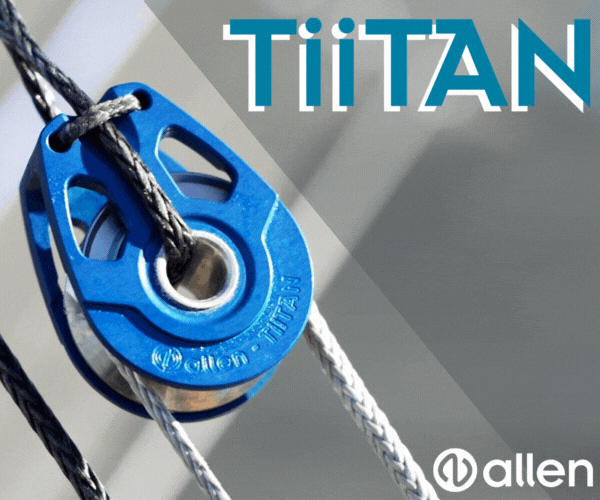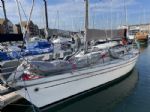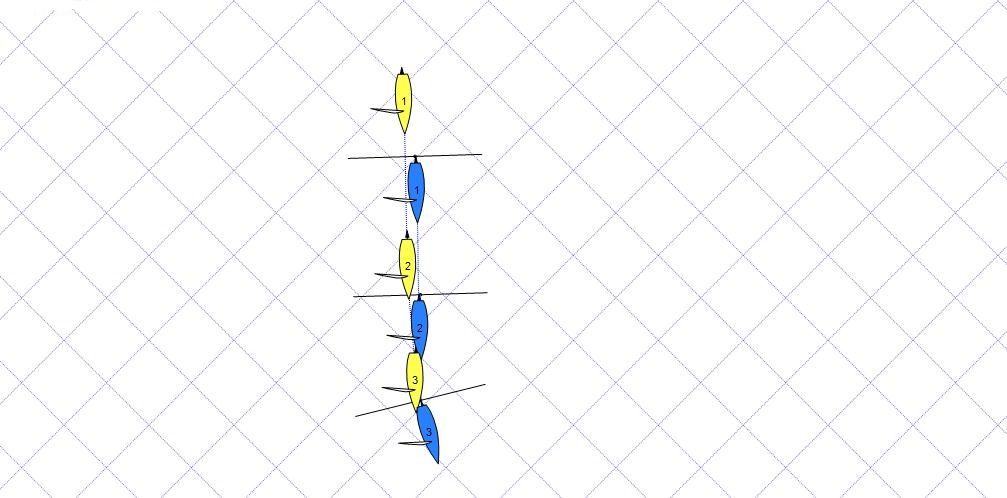











-(1)-202408140552.gif)
| Rossiter Pintail Mortagne sur Gironde, near Bordeaux |
 |
| Laser 28 - Excellent example of this great design Hamble le rice |
 |
List classes of boat for sale |
Rules Question on Overlaps |
Post Reply 
|
Page <123 |
| Author | |
patj 
Really should get out more 
Joined: 16 Jul 04 Location: Wiltshire Online Status: Offline Posts: 643 |
 Post Options Post Options
 Quote Quote  Reply Reply
 Topic: Rules Question on Overlaps Topic: Rules Question on OverlapsPosted: 13 Jul 12 at 1:07pm |
|
I don't see any difference between B hitting the mainsheet of the laser and B hitting the side of the boat forward of the transom (think of a wide Merlin for example) . The outstretched boom is still a part of the boat he should keep clear of - especially as it was outstretched from when B was clear astern and B must know the mainsheet was there as he sails the same class.
B has steered a collision course and so broken rule 14 - would he have ploughed straight through A's sail if A hadn't accelerated? Since they were sailing dead downwind, B as the rearmost boat was windward boat and thus should have kept clear.Edited by patj - 13 Jul 12 at 1:11pm |
|
 |
|
JimC 
Really should get out more 

Joined: 17 May 04 Location: United Kingdom Online Status: Online Posts: 6662 |
 Post Options Post Options
 Quote Quote  Reply Reply
 Posted: 13 Jul 12 at 1:34pm Posted: 13 Jul 12 at 1:34pm |
|
Sorry patj: that's not what windward boat means: you need to read the (crucial) definitions. A was definitely windward boat.
For whatever my opinion is worth Brass is correct: 'twas a rule 15 breach by B. |
|
 |
|
jeffers 
Really should get out more 

Joined: 29 Mar 04 Location: United Kingdom Online Status: Offline Posts: 3048 |
 Post Options Post Options
 Quote Quote  Reply Reply
 Posted: 13 Jul 12 at 3:28pm Posted: 13 Jul 12 at 3:28pm |
Mine too, how I missed Rule 15 when flicking through is anyones guess! I knew there was a reason. Plus (to be fair) gaining an overlap with only 2 feet of clearance is a bit dodgy to say the least (IMO).
|
|
|
Paul
---------------------- D-Zero GBR 74 |
|
 |
|
MrGin 
Newbie 
Joined: 31 Jul 07 Location: United Kingdom Online Status: Offline Posts: 23 |
 Post Options Post Options
 Quote Quote  Reply Reply
 Posted: 13 Jul 12 at 4:07pm Posted: 13 Jul 12 at 4:07pm |
|
So am I right in saying that, on a start line for example, a boat cannot come from behind, go to leeward of another boat and luff, without first going clear ahead? Due to rules 12, 15 & 17, therefore rule 11 does not come into play.
Phil
|
|
|
Phil A8152 "Albaholic"
|
|
 |
|
SoggyBadger 
Really should get out more 
Joined: 26 Oct 10 Location: The Wild Wood Online Status: Offline Posts: 552 |
 Post Options Post Options
 Quote Quote  Reply Reply
 Posted: 13 Jul 12 at 4:33pm Posted: 13 Jul 12 at 4:33pm |
No. Firstly there is no proper course before the start and secondly Rule 17 doesn't apply until the starting signal has been given. So before the start it's just a case of windward boat keep clear and the leeward boat only having to allow him the opportunity to do so. |
|
|
Best wishes from deep in the woods
SB |
|
 |
|
Rupert 
Really should get out more 
Joined: 11 Aug 04 Location: Whitefriars sc Online Status: Offline Posts: 8956 |
 Post Options Post Options
 Quote Quote  Reply Reply
 Posted: 13 Jul 12 at 5:34pm Posted: 13 Jul 12 at 5:34pm |
|
This is all getting a bit more complex than it needs to be. If catching up with a boat ahead, you have a choice of going to windward of it, or to leeward. You can't just run into it, and that includes mainsheets, booms, heads or any other part of the boat or helm, above or below water. Once you have chosen up or down, all these other rules apply.
|
|
|
Firefly 2324, Puffin 229, Minisail 3446 Mirror 70686
|
|
 |
|
Brass 
Really should get out more 
Joined: 24 Mar 08 Location: Australia Online Status: Offline Posts: 1151 |
 Post Options Post Options
 Quote Quote  Reply Reply
 Posted: 14 Jul 12 at 2:03am Posted: 14 Jul 12 at 2:03am |
|
This is an interesting and somewhat quirky scenario.
Perhaps it will help everyone to better understand the solution and method of analysing a rules problem in general if we do the somewhat simpler bow to hull contact scenario from first principles. Rules wonks and judges please note that what is described is an analytical process, not the customary Facts Found, Conclusions and Decision structures that is used to provide written decisions.
Consider the following diagram of the incident described.
 RACING RULES OF SAILING All the relevant rules and definitions are contained in the Racing Rules of Sailing which can be viewed and downloaded here FIRST APPLY DEFINITIONS TO BOATS (AND OTHER OBJECTS) IN THE SCENARIO
@1 Boat B is clear astern of Boat A because her hull and equipment are behind the line abeam of the aftermost point of A's hull and equipment in normal position (Definitions: Clear Astern and Clear Ahead; Overlap). Observe that the diagram illustrates that this line abeam extends from the aftermost end of A's trailing rudder, not from her actual transom.
@2 and @3 B is overlapped (Definitions: Clear Astern and Clear Ahead; Overlap) on A and is to leeeward of A (Definitions: Leeward and Windward). SECOND APPLY THE RULES OF PART 2 SECTION A THE RIGHT OF WAY
@1 B (clear astern) shall keep clear (Definitions: Keep clear) of A (Rule 12). While B was clear astern of A, B kept clear of A. B did not break rule 12. @2, from the time that B and A become overlapped, and @3, A (to windward) shall keep clear of B (to leeward) (Rule 11). While A was overlapped to windward of B there was contact between A and B. A did not keep clear of B. A broke rule 11. This conclusion is correct, regardless of any suggestion that B caused the contact or caused A to break rule 11. This issue can be dealt with by exoneration as discussed below. THIRD APPLY THE RULES OF PART 2 SECTION B GENERAL LIMITATIONS Always leave rule 14 Avoiding Contact till last. If contact has occurred, then one boat or other will always (except in a couple of obscure freak situations) have failed to keep clear of the other (broken a right of way rule) and one boat may have broken a giving room rule (rules 15 and 16). Rule 17 is a 'supplemental' rule that only sometimes applies. it doesn't apply in this scenario and we can disregard it. Rule 16 applies when a right of way boat changes course. In this scenario neither boat changes course while she is right of way boat and rule 16 does not apply. Rule 15 is the rule that is specifically designed to cope with situations like this where right of way changes over ('transitions') between boats in an instant. It certainly does apply. There is no action of A that caused B to acquire right of way over A by becoming overlapped to leeward of A. Rule 15 applies and requires B to initially give A room to keep clear. Room to keep clear means the space that A needs in the existing conditions while manoeuvring promptly in a seamanlike way to keep clear (Definitions: Room). It is evident from the scenario description and the diagram that between the instant that B crosses the 'line abeam' and becomes overlapped on A, there isn't sufficient time or space for A to manoeuvre so as to keep clear of B. B did not initially given A room to keep clear. B broke rule 15. FOURTHLY CONSIDER RULE 14 AVOIDING CONTACT If contact occurred because B did not give A room to keep clear, then it was not reasonably possible for A to avoid contact, and A does not break rule 14. Once B had achieved the close hook-up on A it was clear that A did not and could not keep clear, but B could have avoided contact by bearing away and opening the gap. It was reasonably possible for B to avoid contact, starting from when it was clear to B that A was not keeping clear (rule 14(a)), and thus B broke rule 14. If there was no injury or damage, B, the right of way boat would be protected from penalisation under rule 14, but not under any other rule, by rule 14(b). LASTLY CONSIDER EXONERATION. When a right of way boat breaks a rule, exoneration should be considered. Rule 64.1( c ) provides that: When as a consequence of breaking a rule a boat has compelled another boat to break a rule [the rule requiring that all boats breaking rules to be penalised] does not apply to that boat and she shall be exonerated. In this scenario, B's failure to give A room to keep clear when B initially acquired right of way by becoming leeward boat, prevented A from keeping clear of B and thus compelled A to break rule 11. THE BOTTOM LINE B broke rule 15 by not initially giving A room to keep clear. B broke rule 14 by not avoiding contact when it was reasonably possible to do so. A broke rule 11 by not keeping clear of B, a leeward overlapped boat, but A is exonerated for breaking rule 11 because she was compelled to do so by B breaking rule 15. On valid protest, penalise B. Edited by Brass - 16 Jul 12 at 1:21am |
|
 |
|
Post Reply 
|
Page <123 |
| Forum Jump | Forum Permissions  You cannot post new topics in this forum You cannot reply to topics in this forum You cannot delete your posts in this forum You cannot edit your posts in this forum You cannot create polls in this forum You cannot vote in polls in this forum |
Copyright ©2001-2010 Web Wiz
Change your personal settings, or read our privacy policy











 Printable Version
Printable Version Delicious
Delicious Digg
Digg Facebook
Facebook Furl
Furl Google
Google MySpace
MySpace Newsvine
Newsvine reddit
reddit StumbleUpon
StumbleUpon Twitter
Twitter Windows Live
Windows Live Yahoo Bookmarks
Yahoo Bookmarks Topic Options
Topic Options